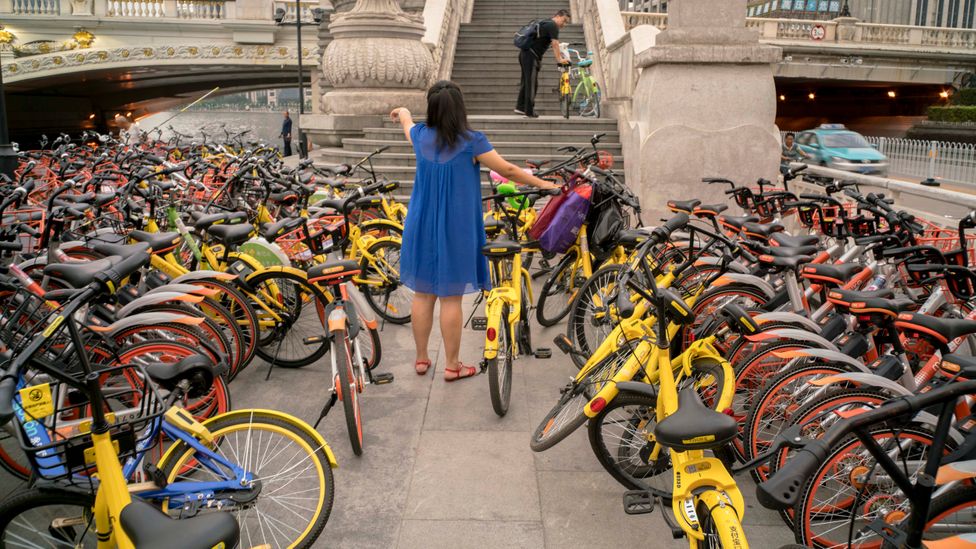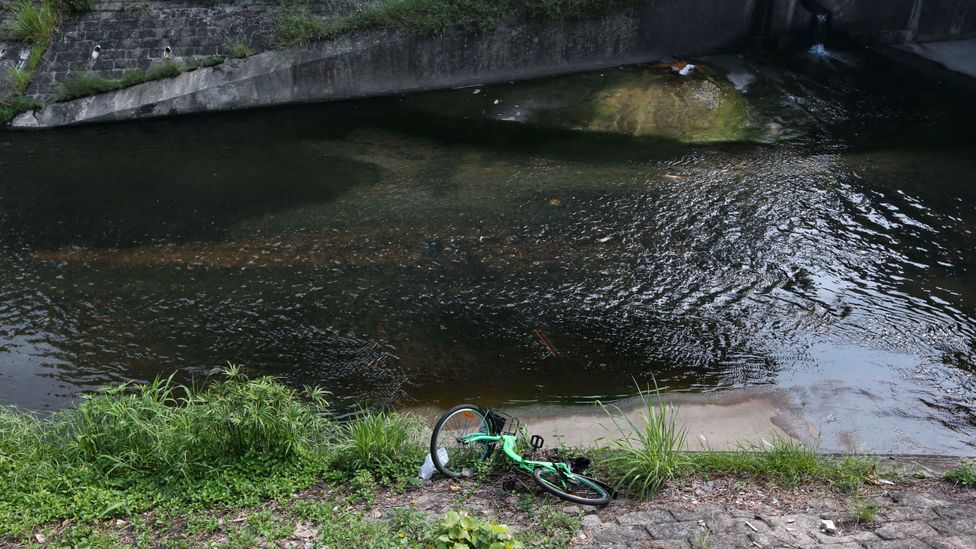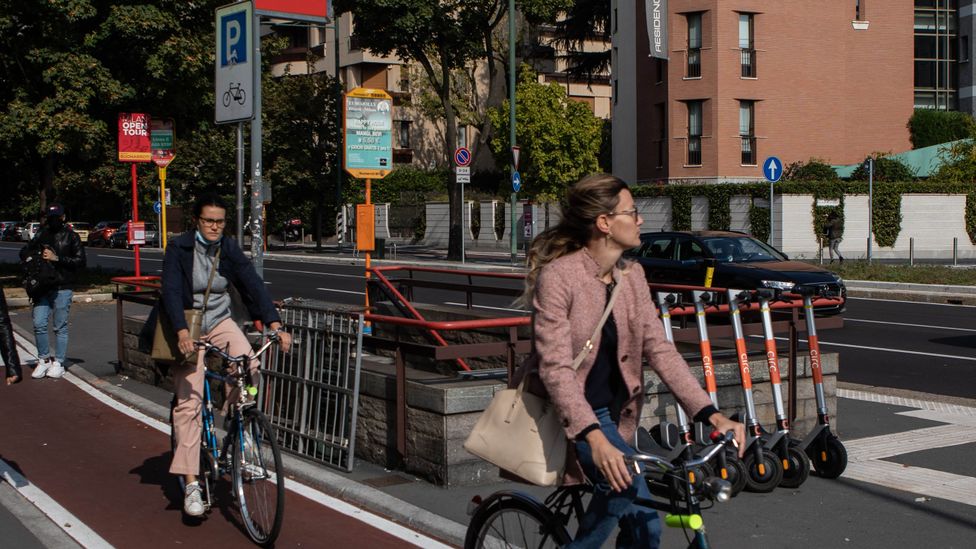A set of iconic photos from 2017 show brightly coloured fields which, at first glance, look like meadows filled with flowers in full bloom. It takes a while to register that the images aren't of verdant fields, but ones filled with bicycles: hundreds and thousands of two-wheelers, stacked end-to-end in what came to be called China's bicycle graveyards.
The fields were the remains of a countrywide boom-to-bust bike share scheme. The scheme had captured the world's imagination for its innovative use of technology involving a smart digital lock and GPS. The digital lock innovation was a game changer for China, which was once known as the "kingdom of bicycles", before the rapid growth of its automobile industry.
The bike share schemes presented a cost-effective alternative solution to traveling in cars, easing traffic congestion in the process. Ofo, one of the country's most well-known bike share companies, had wanted to present a technology-driven transport solution that could serve the needs of people who wanted to travel short distances. They had aimed to match up the existing number of bikes in service with the number of people who needed them. The scheme was a hit with investors seeking green transport solutions for China. Ofo was not the only one to gain interest – its competitors such as Mobike and Bluegogo also garnered substantial interest from venture capitalists and investors.
But while these firms started off with healthy balance sheets, there was no regulatory framework under which these bikes might be gradually introduced and integrated into China's existing public transport system. A sudden influx of what amounted to millions of bikes inundated China's urban centres. The lack of regulation also allowed copycat bike share companies to spring up unchecked, so that at one point, there were more than 40 dockless bike share companies operating around the country, leading to an oversupply of shared bicycles.
You might also like:
- The new fuel in the Saudi Arabian desert
- The 'gold rush' for green lithium
- The futuristic cargo ship made of wood
The sudden growth of the industry meant that China's biggest cities including Shanghai and Hangzhou had to create their own guidelines which were meant to ring fence its players, because by this point, bikeshare bikes were being vandalised, stolen or simply ditched. At one point, more than 3,000 of these two-wheelers were reportedly found in rivers in southern China after a clean-up operation. Bikes are still being uncovered in rivers and vegetation to this day.
The graveyards where excess bicycles and those causing a nuisance were dumped became a massive recycling problem. The digital locks were complex to recycle, with some of the bikes even came with their own micro-sized solar panels, which would charge the bike's batteries when the two-wheelers were not being used, says Kurt Kamminer, a US-based collector of shared bikes. There were other challenges for recycling too, including the durable solid tyres that were hard to separate from the frames.

A multitude of choice of bike shares in large Chinese cities led to a surplus of bikes, many of which ended up abandoned, vandalised or confiscated (Credit: Getty Images)
Some of the unlocked bikes have since been donated to areas hit by natural disasters outside of China, Kamminer notes. Though whether the vast majority were used enough to offset their carbon footprint is unknown. One group of Chinese researchers estimated the carbon footprint of a shared bike at 34.56kg of CO2 over its lifetime, meaning a bike would have to be used for nearly two years before it led to net carbon savings.
"The first wave of dockless systems were completely privatised and unregulated, and most governments agree [at] this point that this was a mistake," Jemilah Magnusson, global communications director for the Institute for Transportation and Development Policy, headquartered in the US. "It was never a system at all, but a competition between private companies who were trying to dominate the market."
Magnusson notes that despite the "cautionary tale" of the early forays into dockless schemes, many bike share schemes are effective and sustainable. Some of the more established bike share systems that have been around for much longer prove it works. With these bikes in use for longer, they have a greater chance to save emissions.
One of the more successful is New York's Citi Bike, which launched in 2013. By 2015, bikers had taken more than 10 million rides – the highest annual rate for any bike share programme. Another example of a successful bike share system can be found in Taiwan, where a number of cities have partnered with the world's biggest bike manufacturer Giant, to run YouBike, and which is now available in several cities across the island.

Many former share bikes ended up as urban waste in cities around the world (Credit: Getty Images)
So what is it that makes one bike share scheme work, and another fail? And how can the pitfalls of bicycle mass graveyards be avoided in other urban areas?
Several factors have a big influence on success or failure of a bike share scheme, write Derlie Mateo-Babiano, senior lecturer in urban planning at the University of Melbourne, and her colleagues at the universities of Queensland and Melbourne.
The first is the physical geography of the city in question. The first is obvious to anyone who has cycled: hills. Hills aren't conducive to broad uptake of cycling schemes and can cause returned bikes to bunch in low-lying areas. Using e-bikes are one solution to this, the researchers note, or paying people extra to return a bike at the top of a hill. In a 2016 study, Mateo-Babiano and colleagues found that accounting for such factors – along with a city's typical temperature and weather – can help choosing the right sites for bicycle distribution, and hence the uptake and success of the scheme.
Another big determinant of a share scheme's success is how well it integrates with existing transport – something that was lacking in the first large initiatives. Mateo-Babiano found that the length of off-road cycle lane leading away from a cycle station strongly affected the usage of bikes – in other words, the better the infrastructure for cyclists, the more use the bikes would get. Getting such infrastructure right has been the key to making cycling in general "irresistible" in countries such as the Netherlands and Germany.
Close cooperation between operators and regulators also helps, particularly in a market like China – where more mature, stable bike sharing companies have already made an industry comeback. These new, regulated companies are already reaping the renewed interest in cycling due to the coronavirus pandemic, which has made people averse to buses, trains and other forms of mass transit where social distancing can be challenging. The early difficulties for China's first large bike share schemes weren't that there was no need for such a system, but with flaws in the early business models, Winston Ma Wenyan, former managing director of China's sovereign wealth fund, the China Investment Corporation, writes in an article for the World Economic Forum.

There are several factors that make a bike share more likely to be successful – including the availability of cycle lanes near bicycle stations (Credit: Getty Images)
Magnusson is optimistic about the future of bikes and bike sharing. "All regions would benefit from increased cycling, especially if it means fewer car trips." The region with the greatest potential for such schemes is Africa, she says. One of the continent's early bike share schemes came in 2016, when Medina Bike launched in Morocco, with more bike share firms popping up in South Africa and Rwanda, among others.
"African cities are among the most rapidly growing in the world, they have high density, low car ownership, and a huge need," says Magnusson. "If these cities were to design for cyclists, with safe routes for cycling everywhere, and a bike share system to increase cycling access, they could avoid the damage that a major increase in cars brings, as well as improving access and quality of life for everyone."
But, she notes, what is important is that cities "create a quality system of bikes and bike infrastructure that provides a real alternative to other, more carbon-intensive modes. Because, if the fields of defunct bicycles of 2017 have taught us anything, it's that no bike share scheme can work in a city that isn't prepared for it.
--
The emissions from travel it took to report this story were 0kg CO2. The digital emissions from this story are an estimated 1.2g to 3.6g CO2 per page view. Find out more about how we calculated this figure here.
--
Join one million Future fans by liking us on Facebook, or follow us on Twitter or Instagram.
If you liked this story, sign up for the weekly bbc.com features newsletter, called "The Essential List". A handpicked selection of stories from BBC Future, Culture, Worklife, and Travel, delivered to your inbox every Friday.
"work" - Google News
January 13, 2021 at 07:15AM
https://ift.tt/2LqGlep
Why some bike shares work and others don't - BBC News
"work" - Google News
https://ift.tt/3bUEaYA
Bagikan Berita Ini














0 Response to "Why some bike shares work and others don't - BBC News"
Post a Comment